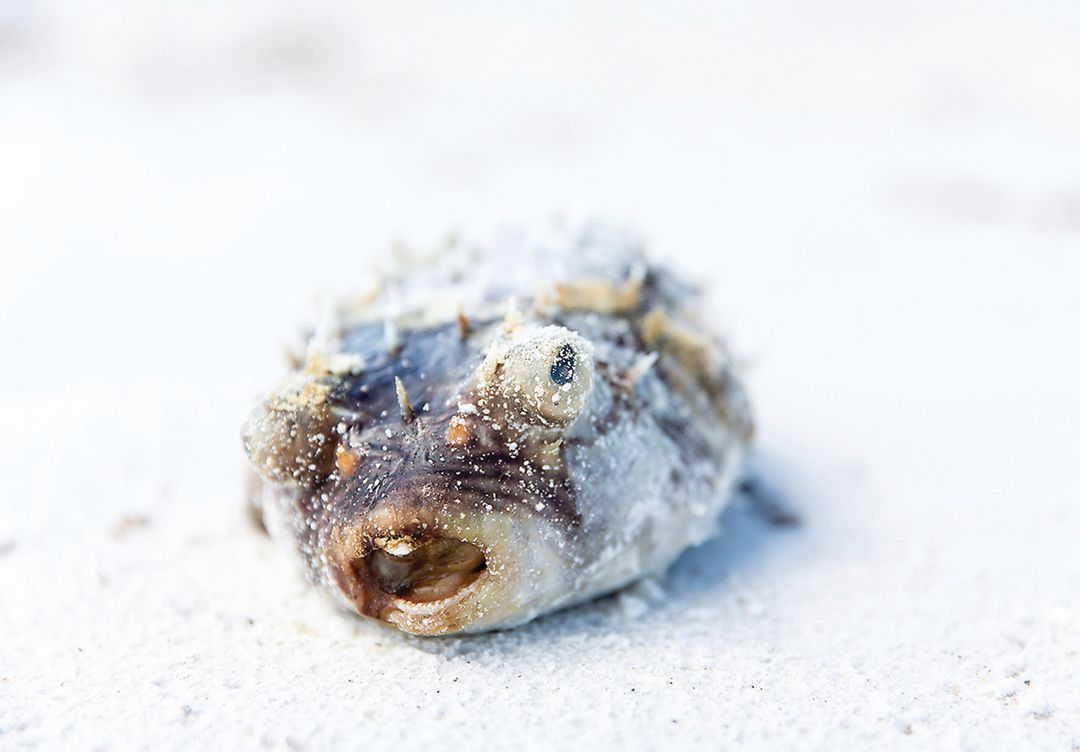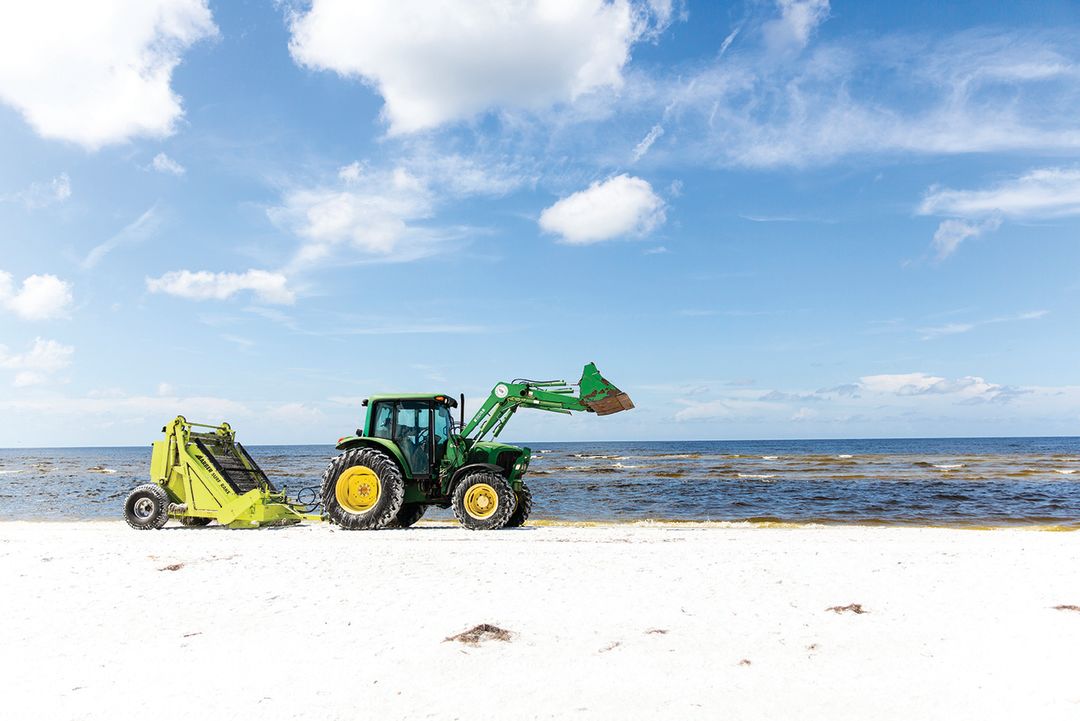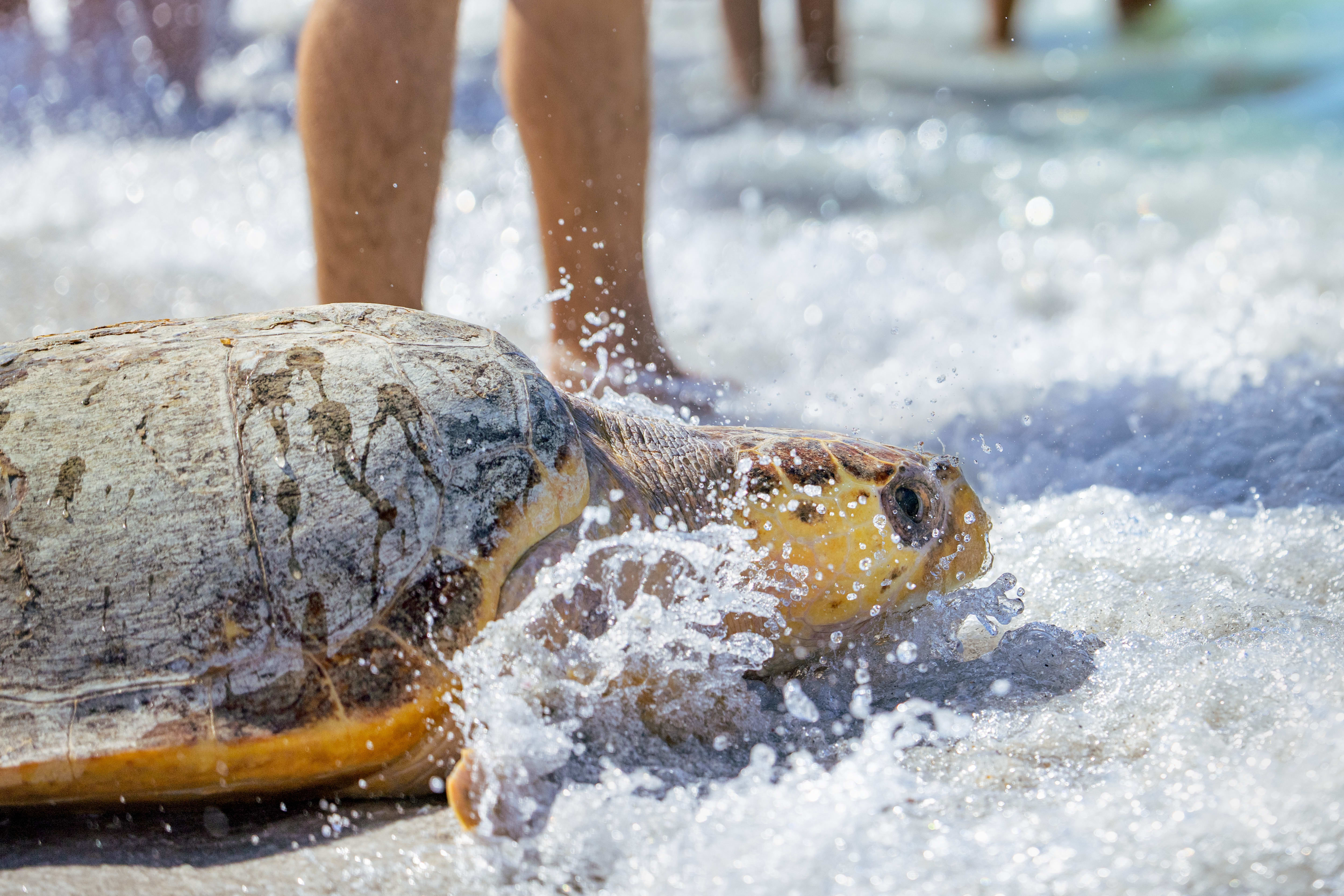It’s Been 12 Months Since Karenia Brevis Washed Ashore. Four Research Projects Hope to Understand Outbreaks

A fish that died as a result of red tide.
Image: Karen Arango
On a muggy morning in early August, Gretchen Lovewell wades into waist-deep water at a home near Dona Bay and heads towards a carcass tucked behind a mangrove stand. A familiar, fetid scent is in the air—the third dead manatee she’s retrieved this month.
Lovewell, a program manager in Mote Marine Laboratory’s Stranding Investigation Program, guides the buoyant body to a boat dock, where she and her colleague, Rebeccah Hazelkorn, use an A-frame crane to lift and load the waterlogged creature into the bed of a truck. After a quick breather, Hazelkorn transports the specimen to a Florida Wildlife Conservation Commission (FWC) facility in St. Petersburg for a necropsy.
It’s too early to tell what killed the sea cow, but the Mote team have their suspicions. Southwest Florida has been inundated by the worst red tide in over a decade, and this month marks one year since the outbreak began. Apocalyptic scenes and sour-rank smells have haunted shorelines from Collier to Pinellas County. Countless fish, hundreds of sea turtles, manatees and dolphins have been killed by toxins from Karenia brevis, the single-celled algae responsible for Florida’s rust-colored blooms. More than 162 tons of dead fish on Sarasota beaches and another 241 tons from Manatee’s shores have been trucked to county landfills. On muggy afternoons in downtown Sarasota in August, the odor of dead fish wafts across parking lots and seeps into buildings. The airborne toxins, even a mile from shore, can make people cough.
In August, Gov. Rick Scott declared a state of emergency over red tide. Sarasota County and the city of Sarasota followed suit shortly after. Local businesses—especially those dependent on tourists and beachgoers—struggled with cancellations. Forty-six percent of Sarasota businesses reported that business was down 50 percent in late August compared to the same time period in 2017, according to a Visit Sarasota survey.
Scientists at Mote, FWC and elsewhere are studying these deadly blooms to better understand why they occur and how we can control them. It’s a misconception that Florida’s red tides are caused by humans—K. brevis is endemic to Florida’s Gulf Coast, as native as cottonmouths and cabbage palms. But many scientists suspect climate change and human activity are making matters worse, fueling blooms with nutrients from agricultural, commercial and residential runoff. Coastal development has also interrupted natural buffers. Mote staff scientist Tracy Fanara is looking at human activity and its role in intensifying red tide.
“There are so many factors that come into play when talking about red tide initiation,” says Fanara, who helped develop an app that lets citizens report red tide. “But there's no statistical data to correlate human impacts to red tide blooms.”
The key to unlocking K. brevis is meticulous monitoring over many years. Data can help connect the dots. For Fanara and her colleagues, that means collecting regular water samples and running high-tech monitoring missions to track the algae and measure ocean conditions like temperature, salinity and pH.
“Long-term datasets will allow us to make connections between environmental conditions and the occurrence of red tide,” says Vincent Lovko, a Mote staff scientist who last year spearheaded a project using an aerial drone to gather data on K. brevis. Researchers often rely on satellite imagery to estimate the extent of a bloom, but when clouds block satellites from taking clear photos, scientists need another way. “That's where the drone comes in.”
Using specialized sensors, the drone captures varying wavelengths of light refracted from the ocean and runs that data through algorithms to detect what’s in the water. Although their flight time is limited to about 40 minutes, Lovko hopes drones can provide more precise measurements and a broader range of data to unpack.

Collecting dead fish on Lido Beach.
Image: Karen Arango
Kate Hubbard, a research scientist at FWC, monitors K. brevis and studies it under controlled conditions to find out what makes it tick. She and her team design lab experiments that replicate the organism’s natural environment, measuring how environmental changes affect its growth and toxicity.
“Having an improved understanding of what's going on with this organism, how it behaves and reacts to its environment, that's a huge priority,” she says.
Hubbard and her colleagues at the FWC have explored ways to control blooms but don’t yet have the capacity to tackle the scale experienced this year.
Meanwhile Mote’s mitigation efforts might reduce the impact of red tide on coastal communities. Fanara and Lovko are collaborating on research using “living docks”—artificial reef structures filled with filter-feeding animals—to extract algae cells and toxins from the water.
And Richard Pierce, an associate vice president for research at Mote, recently performed the first field test of a water treatment system that uses ozone to destroy K. brevis and its toxins in dead-end canals. Adapted from technology used to clean seawater entering Mote Aquarium, the “ozonation” device has shown promising results, eliminating red tide from a 25,000-gallon pool in about a day.
Large-scale mitigation is years away, but this research offers hope for wildlife responders like Gretchen Lovewell and Rebeccah Hazelkorn. In just two months this summer, the team responded to nearly 100 reports about dead sea turtles—almost as many as they received throughout 2017.
“It sucks,” Hazelkorn says after loading the reeking manatee carcass into the bed of the truck. “These are tough for us. But we always say, the moment we stop having feelings is the moment we should quit.”



